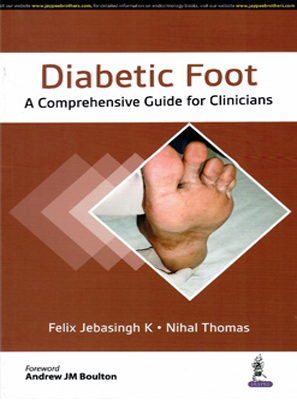Authors
Dr. Nihal Thomas, MD., MNAMS, DNB(Endo), FRACP (Endo), FRCP(Edin), FRCP (Glasg), FRCP (London), FACP, Ph.D (Copenhagen),
Dr. Felix Jebasingh, MD, DM (Endo), DNB (Endo), PGDMLE (Med.Law)
Publisher: Jaypee Brothers Medical Publishers
Quick Overview
 This book focuses on clinical atlas in endocrinology and diabetes a case-based compendium. Endocrinology is a specialty which encompasses a wide spectrum of disorders. Disorders of thyroid, diabetes, obesity, and osteoporosis involve nearly 30% of the population at a random time point in life. This book consists of 7 chapters. Chapter 1 discusses the terrific thyroid (thyroid gland and related disease). Chapter 2 gives a discussion on diabolical diabetes (diabetes mellitus). Chapter 3 discusses the aggressive adrenal (disorders of the adrenal gland). Chapter 4 gives a presentation on pituitary passions. Chapter 5 discusses the bountiful bone (bone and parathyroid disease). Chapter 6 discusses the reminiscences in reproduction and chapter 7 discusses the miscellaneous masquerades. This book focuses on the need of the practicing clinician—whether primary care, physician, surgeon or Endocrine specialist- to handle and identify endocrine problems.
This book focuses on clinical atlas in endocrinology and diabetes a case-based compendium. Endocrinology is a specialty which encompasses a wide spectrum of disorders. Disorders of thyroid, diabetes, obesity, and osteoporosis involve nearly 30% of the population at a random time point in life. This book consists of 7 chapters. Chapter 1 discusses the terrific thyroid (thyroid gland and related disease). Chapter 2 gives a discussion on diabolical diabetes (diabetes mellitus). Chapter 3 discusses the aggressive adrenal (disorders of the adrenal gland). Chapter 4 gives a presentation on pituitary passions. Chapter 5 discusses the bountiful bone (bone and parathyroid disease). Chapter 6 discusses the reminiscences in reproduction and chapter 7 discusses the miscellaneous masquerades. This book focuses on the need of the practicing clinician—whether primary care, physician, surgeon or Endocrine specialist- to handle and identify endocrine problems.
With both a stellar national and indeed international reputation, the Department of Endocrinology, Diabetes & Metabolism has put together a beautifully illustrated and highly instructive colour atlas, assisted by extensive collaboration with many other clinical departments. The illustrations remain outstanding, the text is clear and informative, and the success of the first edition implies that it has indeed been highly educative and useful.
Key Features
- The Endocrine Emporium: Clinical Atlas in Endocrinology and Diabetes, Second Edition, is a comprehensive color atlas that covers every branch of ‘‘Endocrinology: Thyroid, Diabetes, Bone, Pituitary, Adrenal, and other Miscellaneous areas’’.
- This ‘‘Compendium’’ has a problem-based clinical cases, which are serially interrogative and provide comprehensive diagnoses and therapeutic solutions with appropriate cross-references for further reading. Beyond the domain of clinical problems: The radiology, histopathology, and genetic profiles of patients are provided.
- The depth of information is of an encyclopedical quantum. Yet the simplicity may cater to endocrinologists, physicians, surgeons, general practitioners, and students alike!
- Further enticement is provided in the form of multiple-choice questions for every section, selected from the best of question banks to tease the mind and also to prepare for a career pathway involving objective evaluative processes.
Target Audience
Endocrinologists, physicians, surgeons, general practitioners and students
Foreword : Prof. Ashley Grossman

Endocrinology is a very visual specialty. While, as always, a good and detailed history is essential, probably in no other specialisation other than perhaps dermatology is the physical appearance of patients more vital in coming to a correct diagnosis. Patients with Cushing’s syndrome and acromegaly, in particular, have languished for years before the diagnosis was suspected and treatment instituted, and in many other areas recognition of clear clinical features is either ignored, missed, or misattributed. In diabetes, many of the changes over time, particularly those due to a variety of complications, require careful clinical inspection and recognition in order to initiate prompt and often life-saving interventions. Furthermore, both diabetes and endocrinology are increasingly dependent on accurate interpretation of radiological imaging, be it with ultrasound, CT scanning, MRI or radionuclide scanning. It is therefore of great importance that we focus on the visualisation of all aspects of endocrinology and diabetes, and their complications. It is in the light of these considerations, that these authors published their initial atlas some years ago, and it is due to the clear success of this project that I am now delighted to welcome a second edition. As before, it is very much based on the concept of a case-based approach, which has been shown to be an ideal manner to aid the trainee doctor and help educate even experienced clinicians in sharpening their clinical skills, and so assisting in patient management.
As I previously note in my foreword to the first edition, it is especially fitting that this dual approach of teaching endocrinology and diabetes by highly visual techniques and case-based studies comes from the Christian Medical College in Vellore, as one of the most highly praised and accomplished medical centres in Tamil Nadu, India. With both a stellar national and indeed international reputation, the Department of Endocrinology, Diabetes & Metabolism has put together a beautifully illustrated and highly instructive color atlas, assisted by extensive collaboration with many other clinical departments. The illustrations remain outstanding, the text is clear and informative, and the success of the first edition implies that it has indeed been highly educative and useful.
I am delighted to introduce this new edition and, as originally suspected, it is indeed set to become a standard reference in Endocrinology and Diabetes.
Prof Ashley Grossman FMedSci
Professor of Endocrinology
Oxford Centre for Diabetes
Endocrinology and Metabolism
Radcliffe Dept. of Medicine
University of Oxford, Churchill Hospital
Headington, Oxford, OX3 7LE, UK
Foreword : Prof. Nihal Thomas
Endocrinology is a specialty which encompasses a wide spectrum of disorders. Disorders of thyroid, diabetes, obesity, and osteoporosis involve nearly 30% of the population at a random time point in life. This book focuses on the need of the practicing clinician - whether primary care, physician, surgeon or Endocrine specialist to handle and identify endocrine problems.
I would like to thank and acknowledge the hard work and dedication that Dr. Felix Jebasingh K has put into developing several areas of the book. I would like to also appreciate the multidisciplinary impact of several medical specialities across the board in supporting this endeavor.
Just as much this expedition is meant to aid in improving patient care, and support the academician in their learning endeavors, the case discussions and evaluations provided may have a long-term impact on learning processes.
Prof Nihal Thomas
Professor of Endocrinology
Professor & Head, Unit-I
Dept. of Endocrinology, Diabetes & Metabolism
Christian Medical College, Vellore
Tamil Nadu, India








